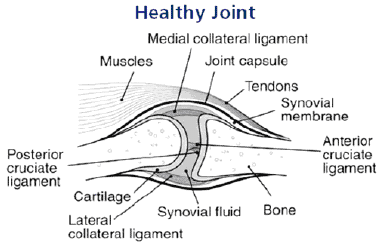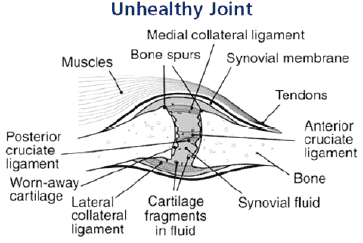|
Glucosamine is a
widely used ingredient that occurs naturally in the body of
warm-blooded animals, and forms an important building block of joint
cartilage. Glucosamine may help build tissue that holds water
providing cartilage thickness and giving it a cushioning effect.
Dozens of scientific studies with animals and humans have clearly
demonstrated that dietary supplementation of glucosamine in
combination with chondroitin, another building block of cartilage,
benefits connective tissues. The best-known clinical study is the
4-year one known as the Glucosamine/chondroitin Arthritis
Intervention Trial (GAIT), conducted at 16 sites across the United
States. This double-blind, placebo-controlled study was sponsored by
the government funded National Institute of Health (NIH), and was
published in 2005 in the New England Journal of Medicine. This
study, which enrolled nearly 1,600 patients, showed that when
Glucosamine and Chondroitin were used in combination, they resulted
in relief of knee pain in nearly 79% of patients with moderate to
severe osteoarthritis; significantly more than either the placebo
control group, or patients that were treated with the common NSAID
drug Celecoxib (Celebrex).
 
Quality
Nearly all glucosamine originates in China and nearly all is
produced from shellfish. The quality of glucosamine varies and is
sometimes not of the expected purity. Several consumer studies have
brought to light that glucosamine products sold in stores contain
between 0% and 115% of the glucosamine claimed on the labels. This
is not to say that manufacturers add less than the desired amount on
purpose, but rather that the glucosamine used is of dubious quality.
Another problem with commonly used glucosamine is that people who
are shellfish intolerant may respond adversely to shellfish-derived
glucosamine, even though the chemical process should eliminate
almost any proteins present in the source material.
Glucosamine Sulfate of Glucosamine
HCL?
Pure glucosamine molecules are chemically unstable, and
manufacturers of glucosamine products must therefore purchase a
stabilized form of this molecule, which is done by converting it
into a salt. Typical forms of glucosamine salts are [glucosamine.HCl],
better known as glucosamine hydrochloride, and
[glucosamine.SO4.2KCl], or glucosamine sulfate. There is a fair
amount of controversy about which salt form is easiest assimilated
by the body, although in reality both salts, in the pure form,
deliver equally effective amounts of the desired glucosamine to
joint cartilage. The explanation is straightforward; in the acidic
environment of the stomach, the stable glucosamine salt molecule is
quickly ionized into a positively charged glucosamine ion and a
negatively charged chloride or sulfate ion. Only the pure
glucosamine relates to the observed benefits relative to
osteoarthritis.
There is another important difference between the two forms,
however, and that is the weight of the glucosamine molecule. The
SO4.2KCl portion of the sulfate salt form is much heavier than the
HCl portion of the hydrochloride form. Another way of looking at
this is, that one molecule of glucosamine chloride contains
approximately 80% pure glucosamine, while one molecule of
glucosamine sulfate contains only about 60%. Therefore, glucosamine
hydrochloride yields considerably more pure glucosamine, and it
takes therefore less of the hydrochloride salt form to derive at the
same absolute label claim of glucosamine than when using the sulfate
salt form, so that the tablets can be smaller. A word of caution
when comparing concentrations of glucosamine present in products
from different manufacturers; it is important to notice whether the
label claim is presented as pure glucosamine or as the glucosamine
salt. For example, a label claim of 400 mg glucosamine (as
glucosamine sulfate) is very different from a claim of 400 mg
glucosamine sulfate, which would represent only 240 mg glucosamine.
Regenasure® Vegetarian Glucosamine
Cargill, an international provider of food and agricultural
products, is the sole producer of a patented, vegetarian form of
glucosamine, i.e., a non-shellfish, non-animal derived form of this
popular ingredient. This form of glucosamine is marketed under the
brand name Regenasure® glucosamine. The stabilized chemical form of
this molecule is the hydrochloride salt, as this form yields the
most glucosamine per unit weight. Nevertheless a major disadvantage
of this vegetarian glucosamine is that it costs about two to three
times as much as the more popular animal-derived forms of
glucosamine. Regenasure® glucosamine is pharmaceutical grade and
therefore of the highest possible purity, and is produced by means
of a unique and patented fermentation process. Not only is
Regenasure® glucosamine of high quality, it also is obtained from
corn and therefore not subject to the shortcomings of animal-derived
glucosamine. This important fact is a major benefit to people and
pets allergic to shellfish.
return to previous page |